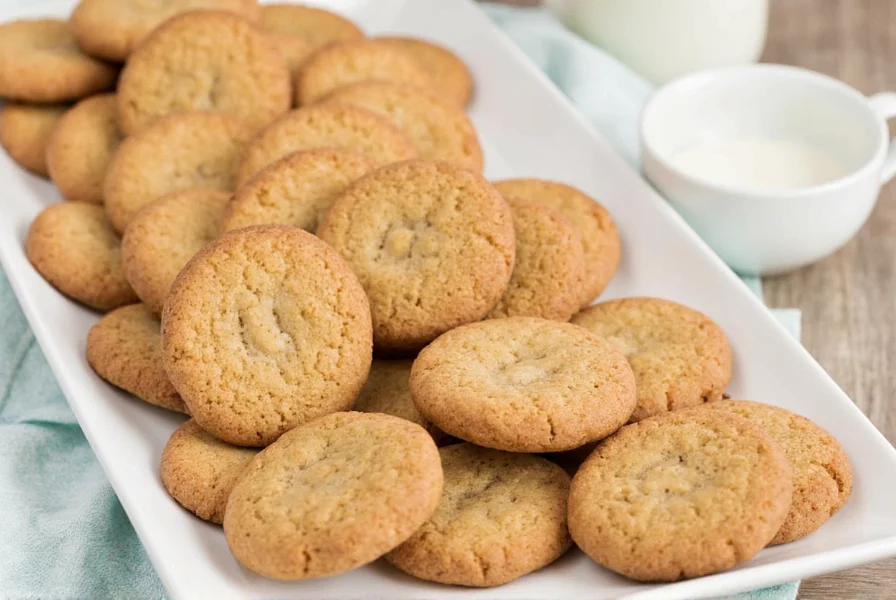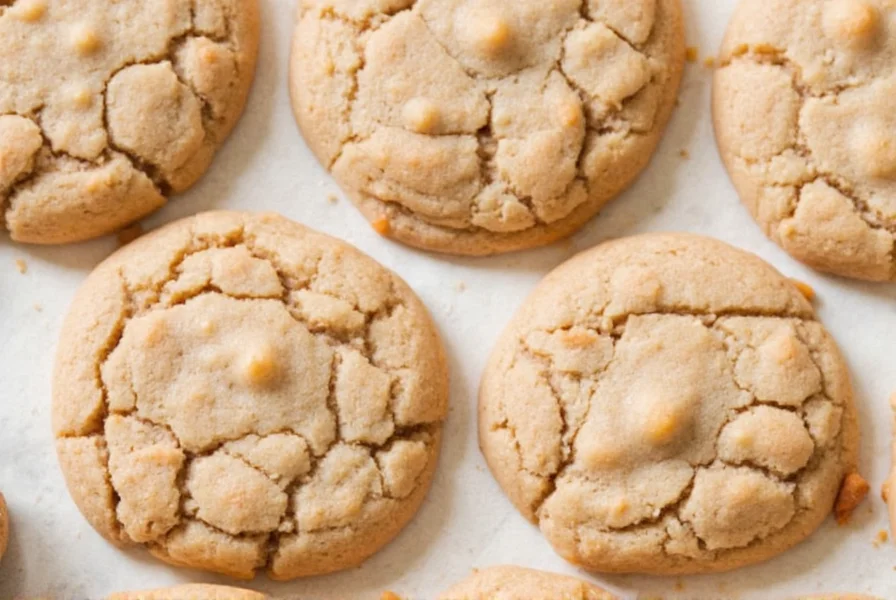Ginger snap cookies stand among the most beloved holiday treats, offering a perfect balance of spicy warmth and sweet comfort. These crisp, flavorful cookies get their name from the audible "snap" when broken due to their firm texture. Unlike softer ginger cookies, authentic ginger snaps maintain their shape while delivering an intense ginger punch that intensifies as they cool.
The Science Behind Perfect Ginger Snaps
Understanding the chemistry behind ginger snap cookies transforms good baking into exceptional results. The distinctive crackled surface forms during baking as the cookie's exterior sets faster than the interior, creating tension that results in those characteristic cracks. This phenomenon depends on several precise factors:
| Ingredient | Function in Ginger Snaps | Optimal Ratio |
|---|---|---|
| Molasses | Provides deep flavor, acidity, and moisture retention | ¼ cup per batch |
| Ground Ginger | Primary spice with warm, pungent notes | 2-3 tsp per batch |
| Granulated Sugar | Promotes crispness and cracking surface | 1 cup per batch |
| Butter | Creates tender crumb while supporting structure | ½ cup per batch |
The crystalline structure of granulated sugar plays a crucial role in achieving that signature snap. Unlike brown sugar which retains moisture, white sugar encourages crispness as it recrystallizes during cooling. The acidity in molasses reacts with baking soda to create lift while enhancing ginger's spicy notes. Professional bakers emphasize that chilling the dough for at least 2 hours prevents excessive spreading, ensuring cookies maintain their classic round shape with defined edges.
Essential Ingredients Breakdown
Not all ginger snap recipes deliver authentic results. The best traditional ginger snap cookies use specific ingredient forms that maximize flavor development:
Molasses selection matters significantly. Use robust or dark molasses for pronounced flavor, avoiding blackstrap which brings bitter notes. The ginger component requires special attention—combine ground ginger for immediate warmth with freshly grated ginger for bright, zesty notes. Many home bakers don't realize that ginger's volatile compounds begin degrading after 6 months, so check your spice cabinet's freshness before baking.
Professional pastry chefs recommend blooming ground spices in melted butter before incorporating other ingredients. This technique extracts maximum flavor compounds, creating deeper, more complex ginger snap cookies that improve in flavor over 24 hours as spices meld.

Step-by-Step Baking Guide
Follow this professional technique for flawless ginger snaps every time:
- Prepare ingredients: Measure all ingredients precisely using kitchen scales for consistency
- Bloom spices: Melt butter and stir in ground ginger, cinnamon, and cloves over low heat for 2 minutes
- Cream sugars: Combine white sugar and molasses until fully incorporated (about 3 minutes)
- Chill dough: Refrigerate minimum 2 hours (overnight preferred) to prevent spreading
- Shape cookies: Roll tablespoon portions in additional sugar for crackled surface
- Bake precisely: 350°F (175°C) for 10-12 minutes until edges darken slightly
- Cool properly: Transfer to wire rack immediately to prevent bottom over-baking
The critical moment comes when removing cookies from the oven. They'll appear underdone but will firm up as they cool. Resist the temptation to bake longer—this common mistake produces brittle, overly hard cookies rather than the desired crisp-yet-snap texture.
Common Problems & Solutions
Even experienced bakers encounter issues with ginger snap cookies. Understanding these problems ensures consistent results:
- Problem: Cookies spread too much - Solution: Chill dough longer (minimum 2 hours), verify oven temperature with thermometer, reduce butter temperature before mixing
- Problem: Cookies too hard/brittle - Solution: Reduce baking time by 1-2 minutes, check molasses freshness, avoid overmixing dough
- Problem: Lack of ginger flavor - Solution: Use fresher spices, bloom spices in butter, add ¼ tsp black pepper to enhance ginger notes
- Problem: No cracking surface - Solution: Ensure proper sugar coating before baking, verify baking soda freshness, don't over-chill dough before baking
Professional bakers note that humidity dramatically affects ginger snap texture. On humid days, increase flour by 1-2 tablespoons and reduce molasses by 1 teaspoon to maintain proper consistency. The ideal ginger snap should bend slightly before snapping cleanly when broken.
Creative Variations
While traditional ginger snap cookies delight purists, these adaptations accommodate various preferences without sacrificing quality:
Gluten free ginger snap cookies require careful flour selection. A blend of rice flour, tapioca starch, and almond flour (in 2:1:1 ratio) produces the closest texture to wheat-based versions. Add ½ teaspoon xanthan gum to prevent crumbliness. Many gluten-free bakers report better results when chilling dough for 4 hours minimum.
Vegan ginger snap cookies substitute butter with refined coconut oil (which lacks coconut flavor) and replace eggs with flax eggs (1 tbsp ground flax + 3 tbsp water per egg). The key adjustment is reducing liquid by 2 teaspoons to compensate for flax egg moisture. Professional vegan bakers recommend adding ⅛ teaspoon apple cider vinegar to enhance ginger flavor.
Storage & Serving Recommendations
Proper storage maintains ginger snaps' signature texture. Keep cookies in airtight containers with parchment between layers for up to 2 weeks. For extended freshness, freeze baked cookies for up to 3 months—thaw at room temperature for 30 minutes before serving.
Ginger snap cookies actually improve in flavor after 24-48 hours as spices fully integrate. The ideal serving temperature is room temperature, though some prefer them slightly warmed. Pair with vanilla ice cream for classic ginger snap cookie ice cream sandwiches, or crumble over custard for elegant dessert presentation.
Frequently Asked Questions
Why do my ginger snap cookies spread too much?
Excessive spreading typically occurs when dough isn't sufficiently chilled (minimum 2 hours required), butter is too warm during mixing, or oven temperature runs low. Verify your oven temperature with a separate thermometer and chill dough overnight for best results. Humid conditions also contribute to spreading—add 1-2 tablespoons extra flour on humid days.
How can I make my ginger snap cookies less hard?
Reduce baking time by 1-2 minutes and remove cookies when edges just begin darkening. They'll continue firming as they cool. Using fresher molasses (within 6 months) and checking baking soda freshness (replace every 6 months) also prevents excessive hardness. The ideal ginger snap should bend slightly before snapping cleanly when broken.
What's the difference between ginger snaps and gingerbread cookies?
Ginger snaps are thinner, crisper cookies with higher sugar content that creates their signature "snap" when broken. Gingerbread cookies typically contain more molasses and less sugar, resulting in softer, cake-like texture. Ginger snaps use primarily ground ginger while gingerbread often includes additional spices like allspice and nutmeg in greater proportions.
Can I make soft ginger snap cookies instead of crisp?
Yes, but they won't be traditional ginger snaps. For softer cookies, increase molasses to ⅓ cup, reduce granulated sugar to ¾ cup, and add 1 extra egg yolk. Bake 1-2 minutes less and store in airtight container with slice of bread to maintain softness. Note these will lack the characteristic snap but offer chewier texture.
Why aren't my ginger snaps cracking on top?
Insufficient cracking usually results from inadequate sugar coating before baking, over-chilled dough, or expired baking soda. Roll dough balls in additional granulated sugar immediately before baking. Ensure baking soda is fresh (replace every 6 months). Dough should be cold but not frozen—let chilled dough sit at room temperature for 5 minutes before baking for optimal cracking.











 浙公网安备
33010002000092号
浙公网安备
33010002000092号 浙B2-20120091-4
浙B2-20120091-4